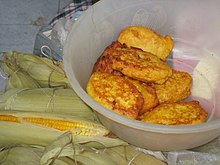
Summary
Corn fritters are fried cakes of a dough or batter made of, or containing a featured quantity of maize (corn). Originating in Native American cuisine, they are a traditional sweet and savory snack in the Southern United States, as well as Indonesia where they are known as perkedel jagung or bakwan jagung.[1]
 Bowl of corn fritters | |
| Type | Fritters |
|---|---|
| Course | Snack |
| Place of origin | Native American cuisine |
| Region or state | Americas, China, Southeast Asia |
| Created by | Native Americans in the United States |
| Main ingredients | Corn, egg, flour, milk and butter |
| |
History edit
Native Americans had been using ground corn (maize) as food for thousands of years[2] before European explorers arrived in the New World.[3] Corn-based products, such as corn flatbread, arepa and cornbread were staple foods in Pre-Columbian Americas. Native Americans did not use deep frying techniques, however, which require ample supplies of cooking oil as well as equipment in which the oil can be heated to high temperatures.
European settlers learned recipes and processes for corn dishes from Native Americans, and soon devised their own cornmeal-based recipe variations of European breads made from grains available on that continent. The corn fritter probably was invented in the Southern United States, whose traditional cuisine contains a lot of deep fried foods.
On the other side of the world, maize seeds from the Americas were introduced into Southeast Asia in the late 16th century through Spanish and Portuguese traders. The plant thrived in the tropical climate of Indonesia, and soon became a staple food plant in drier areas of central and southeastern Indonesia, since it requires much less water than wet rice. Coconut and palm oil have been essential elements of Indonesian cuisine for centuries. The deep fried technique using palm oil was probably borrowed from Portuguese colonists; and Indonesia and Myanmar (Burma) both have their own types of corn fritter, respectively called perkedel jagung or bakwan jagung and pyaungbu kyaw.[1]
Regional variations edit
Southern United States edit
Traditional corn fritters in the American South use corn kernels, egg, flour, milk, and melted butter.[4] They can be deep fried,[5] shallow fried,[5] baked, and may be served with jam, fruit, honey, or cream. They may also be made with creamed corn, baked, and served with maple syrup. Corn fritters can be made to have a similar appearance to, and thus be mistaken for, johnnycake.
They are sometimes called corn nuggets.[6]
Peru edit
Peruvian corn fritters, called torrejas de choclo, are made from choclo (Peruvian corn), an Andean variety of corn, pepper, onion and eggs. They can deep fry in vegetable oil and is usually served savory to accompany other local dishes as an appetizer.[7]
Southeast Asia edit
Corn is believed to have been introduced in Southeast Asia from Central America in 16th century by the Portuguese or the Spanish as part of the Columbian exchange and has become integrated into Southeast Asian cuisines.[8]
Cambodia edit
Cambodian corn fritters, called poat chien (Khmer: ពោតចៀន), are made from a mixture of thinly sliced corn kernels, grated coconut, coconut milk and glutinous rice flour fried in vegetable oil. They are eaten as a snack throughout the day.[9]
Indonesia edit
Indonesian corn fritters, a type of gorengan, are not sweet but savoury. They have a more granulated texture, as the corn kernels are not finely ground and blended into the dough, so they retain their kernel shapes. The fritter is made from fresh corn kernels, a mixture of flours including wheat flour, rice flour, corn starch, sago or tapioca, celery, scallion, eggs, shallots, garlic, salt and pepper, and deep fried in coconut oil. They are a popular snack and are often served as an appetizer.[10]
In Bojonegoro[11] and Tuban,[12] East Java, a corn fritter is called pelas. Unlike bakwan jagung, pelas uses corn which is ground with a stone mortar and pestle and mixed with spices.
Myanmar (Burma) edit
Burmese corn fritters, called pyaungbu kyaw (ပြောင်းဖူးကြော်), are a type of Burmese fritter. Pyaungbu kyaw consists of corn kernels battered in flour and eggs and deep-fried as disk-like fritters.[13][14] They are savory, and are similar to Indonesian bakwan jagung.
See also edit
Food portal
References edit
- ^ a b Elaine Louie. "Indonesian Corn Fritters". The New York Times.
- ^ Teosinte was known in Rio Balsas (Mexico) valley from 9000 BP and was introduced in what is now the United States by the Anasazis circa 1000 AD
- ^ "Corn Bread". Indians.org.
- ^ Roupe, Diane (2007). The Blue Ribbon Country Cookbook. Thomas Nelson Inc. p. 390. ISBN 978-1401603601.[permanent dead link]
- ^ a b Hiller, Elizabeth O. (1918). The Corn Cook Book. P.F. Volland Co. pp. 73–75.
Corn fritters.
- ^ Moss, Robert F. (2011-03-02). "An Orangeburg family spawns a loosely connected barbecue empire across S.C." Charleston City Paper. Retrieved 2023-08-15.
- ^ "Torrejas de choclo: aprende a preparar un clásico chiclayano que se puede acompañar con todo". El Comercio (in Spanish). 4 July 2022. Retrieved 7 January 2023.
- ^ Van Esterik, Penny (2008). "Corn and other staple foods". Food Culture of Southeast Asia. Greenwood Press. p. 22. ISBN 978-0-313-34419-0.
- ^ De Monteiro, Longteine; Neustadt, Katherine (1998). The Elephant Walk Cookbook: Cambodian Cuisine from the Nationally Acclaimed Restaurant. Houghton Mifflin Harcourt. p. 60. ISBN 0395892538.
- ^ Anita (12 June 2013). "Bakwan Jagung – Corn Fritter". Daily Coking Quest. Archived from the original on 30 July 2016. Retrieved 10 August 2016.
- ^ Fadllan, Nellia. "Pelas Jagung Bojonegoro". dimanaaja.com (in Indonesian). Retrieved 27 May 2023.
- ^ S, Heri. "Pelas Palang, Kudapan Khas Warga Pesisir Tuban". tubankab.go.id (in Indonesian). Government of Tuban Regency. Retrieved 27 May 2023.
- ^ "ပြောင်းဖူးကြော် ကြွပ်ကြွပ်ရွရွလေး ကြော်စားကြမယ်". MyFood Myanmar (in Burmese). 2018-08-25. Archived from the original on 2018-08-29. Retrieved 2021-11-03.
- ^ Aurora (2019-09-29). "ချိုဆိမ့်ဆိမ့်အရသာလေးနဲ့ အကြိုက်တွေ့ကြမယ့် ချိစ်ပြောင်းဖူးကြော်". ဧရာဝတီ (in Burmese). Archived from the original on 2019-10-05. Retrieved 2021-11-03.


